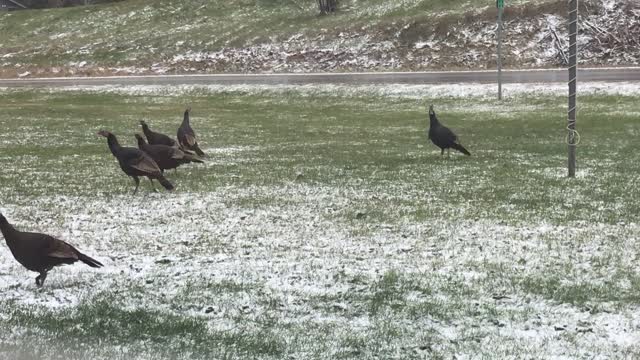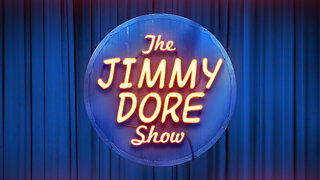Premium Only Content

Wild turkeys afraid to cross the main road
Welcome everyone. Take a look at all these wild turkeys on my property here in NH. It's late October and the snow is falling. These turkeys love to feed on my property. Not seen in this video are 2 apple trees and a berry tree with fruit all over them and on the ground outback on my property.
Toms (adult males) weigh 18-24 pounds or more; hens (females) about 10 pounds. Plumage is iridescent bronze; dark in males and tips rusty or light brown in females. Wings and fan-shaped tail show alternating dark bands. Neck and head of adult males is reddish, while females have bluish heads with more feathers.
A dewlap (fleshy growth hanging under chin), caruncles (growths located on the side and front of neck), and a snood (a fleshy projection rising above the bill) adorn males. A beard (like bristles on a broom) hangs down from the chest; typical in males and in 5% of females. Males have spurs 1/4 to 1-1/4 inch long on the lower legs.
Turkeys forage on the ground in flocks, occasionally mounting shrubs and small trees. Acorns, beechnuts, cherries, and ash seeds are primary food sources. Seeds, berries, grasses, sedges and insects are important summer foods. Turkeys eat corn, rye, oats, alfalfa, soybeans, millet, and buckwheat. Grit is important. Adults eat 90% plant matter and 10% insects. Poults eat mainly insects. In winter turkeys visit seeps; they feed on sensitive fern fertile stalks, waste corn, and persistent fruits such as barberry, rose hips, and dried apples.
Adult males gobble to attract females and to repel competing males. Both adults make a variety of noises - yelps, clucks, cackles, purrs, rattles, and gobbles. Wild Turkeys are polygamous. Toms gather a harem of hens by gobbling, strutting, and using dramatic plumage displays. Mating occurs in April and nesting in May. The nest is typically a small depression lined with dead leaves. Nests are located in areas with a well-developed understory or in cut-over areas with slash.
-
 LIVE
LIVE
BonginoReport
7 hours agoAI & The Woke Indoctrination Ruining Childhood - Nightly Scroll w/ Hayley Caronia (Ep.123)
12,117 watching -
 1:17:29
1:17:29
Kim Iversen
4 hours agoTrotskyite Neocons: How MARXISTS Built the Modern GOP
31.3K45 -
 LIVE
LIVE
The Jimmy Dore Show
2 hours agoImmigrant Firefighters ARRESTED By Border Patrol! Zionists CENSORING Wikipedia! w/ Dave DeCamp
4,546 watching -
 LIVE
LIVE
Nerdrotic
3 hours ago $3.19 earnedLet's TACO-bout Take Us North, Hollywood COPE! Cracker Barrel CRACKED! | Friday Night Tights 369
1,690 watching -
 LIVE
LIVE
StoneMountain64
3 hours ago#1 Battlefield Mastery Session with the BOYS
199 watching -
 1:23:45
1:23:45
Roseanne Barr
4 hours agoDeclassifying Presidential Sex Slavery W/ Cathy O’Brien | The Roseanne Barr Podcast #113
81K26 -
 LIVE
LIVE
FusedAegisTV
18 hours agoHollow Knight Silksong Waiting Room ~~ pt. I
89 watching -
 8:37
8:37
Warren Smith - Secret Scholar Society
7 hours agoJesse Lee Peterson EXPOSES How Stupid David Pakman Really Is
10.2K5 -
 44:44
44:44
Scammer Payback
9 hours agoCrazy Confrontation with Hacked Scammer Group
4.56K2 -
 1:09:00
1:09:00
vivafrei
4 hours agoKamala Harris Security Being "Pulled"? Kilmar Wants Trump Admin GAGGED! Fake News GALORE & MORE!
59.4K34